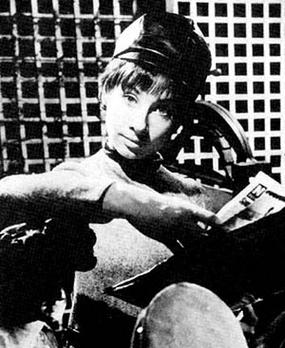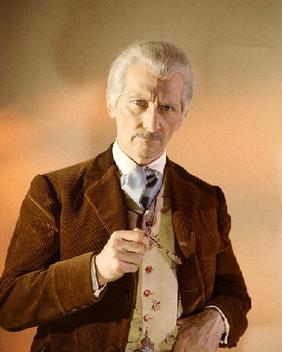
Doctor Who is a British science fiction television series broadcast by the BBC since 1963. The series, created by Sydney Newman, C. E. Webber and Donald Wilson, depicts the adventures of an extraterrestrial being called the Doctor, part of a humanoid species called Time Lords. The Doctor travels in the universe and in time using a time travelling spaceship called the TARDIS, which externally appears as a British police box. While travelling, the Doctor works to save lives and liberate oppressed peoples by combating foes. The Doctor often travels with companions.

Skaro is a fictional planet in the British science fiction television series Doctor Who. It was created by the writer Terry Nation as the home planet of the Daleks.

Daleks' Invasion Earth 2150 A.D. is a 1966 British science fiction film directed by Gordon Flemyng and written by Milton Subotsky, and the second of two films based on the British science-fiction television series Doctor Who. It stars Peter Cushing in a return to the role of the eccentric inventor and time traveller Dr. Who, Roberta Tovey as Susan, Jill Curzon as Louise and Bernard Cribbins as Tom Campbell. It is the sequel to Dr. Who and the Daleks (1965).

An Unearthly Child is the first serial of the British science fiction television series Doctor Who. It was first broadcast on BBC TV in four weekly parts from 23 November to 14 December 1963. Scripted by Australian writer Anthony Coburn, the serial introduces William Hartnell as the First Doctor and his original companions: Carole Ann Ford as the Doctor's granddaughter, Susan Foreman, with Jacqueline Hill and William Russell as school teachers Barbara Wright and Ian Chesterton. The first episode deals with Ian and Barbara's discovery of the Doctor and his time-space ship, the TARDIS, in a junkyard in contemporary London, and the remaining episodes are set amid a power struggle between warring Stone Age factions who have lost the secret of making fire.
Amicus Productions was a British film production company, based at Shepperton Studios, England, active between 1962 and 1977. It was founded by American producers and screenwriters Milton Subotsky and Max Rosenberg.

The Daleks is the second serial in the British science fiction television series Doctor Who, which was first broadcast on BBC TV in seven weekly parts from 21 December 1963 to 1 February 1964. Written by Terry Nation and directed by Christopher Barry and Richard Martin, this story marks the first appearance of the show's most popular villains, the Daleks, and the recurring Skaro people, the Thals.
Planet of the Daleks is the fourth serial of the tenth season of the British science fiction television series Doctor Who, which was first broadcast in six weekly parts on BBC1 from 7 April to 12 May 1973. It was the first Dalek story to be written by their creator Terry Nation since 1965’s The Daleks' Master Plan.
Genesis of the Daleks is the fourth serial of the twelfth season of the British science fiction television series Doctor Who. It was written by Terry Nation and directed by David Maloney, and originally broadcast in six weekly parts from 8 March to 12 April 1975 on BBC1.
Day of the Daleks is the first serial of the ninth season of the British science fiction television series Doctor Who, which was first broadcast in four weekly parts from 1 to 22 January 1972. It was the first of four Third Doctor serials to feature the Daleks, which returned to the series for the first time since The Evil of the Daleks (1967).

Ian Chesterton is a fictional character in the British science fiction television series Doctor Who and a companion of the First Doctor. He was played in the series by William Russell and was one of the members of the programme's first regular cast, appearing in much of the first two seasons from 1963 to 1965. In a film adaptation of one of the serials, Dr. Who and the Daleks (1965), he was played by Roy Castle, but with a very different personality and backstory. Ian appeared in 16 stories and 77 episodes. He later returned for a cameo appearance, played once again by Russell, in the 2022 episode "The Power of the Doctor".

Barbara Wright is a fictional character in the British science fiction television series Doctor Who and a companion of the First Doctor. She was one of the programme's first regulars and appeared in the bulk of its first two seasons from 1963 to 1965, played by Jacqueline Hill. Prior to Hill being cast the part had originally been offered to actress Penelope Lee, who turned the role down. Barbara appeared in 16 stories. In the film version of one of the serials, Dr. Who and the Daleks (1965), Barbara was played by actress Jennie Linden, but with a very different personality and backstory, which includes her being a granddaughter of "Dr Who".

Susan Foreman is a fictional character in the British science fiction television series Doctor Who. The granddaughter of the Doctor and original companion of their first incarnation, she was played by actress Carole Ann Ford from 1963 to 1964, in the show's first season and the first two stories of the second season. Ford reprised the role for the feature-length 20th anniversary episode "The Five Doctors" (1983) and the 30th anniversary charity special Dimensions in Time (1993).

The Dalek Invasion of Earth is the second serial of the second season in the British science fiction television series Doctor Who. Written by Terry Nation and directed by Richard Martin, the serial was broadcast on BBC1 in six weekly parts from 21 November to 26 December 1964. In the serial, the First Doctor, his granddaughter Susan Foreman, and teachers Ian Chesterton and Barbara Wright discover that the Earth in the 22nd century has been occupied by Daleks. They work with a human resistance group to stop the Daleks from mining out the Earth's core as part of their plan to pilot the planet through space.

The Chase is the eighth serial of the second season in the British science fiction television series Doctor Who. Written by Terry Nation and directed by Richard Martin, the serial was broadcast on BBC in six weekly parts from 22 May to 26 June 1965. Set in multiple time periods on several different planets, including Aridius, Earth, and Mechanus, the serial features the Dalek race travelling through time while pursuing the TARDIS and its occupants—the First Doctor and his companions Ian Chesterton, Barbara Wright, and Vicki —to kill them and seize the TARDIS for themselves. The Doctor and companions encounter several characters, including monsters Dracula and Frankenstein's monster, human astronaut Steven Taylor, and an android replica of the Doctor.
The Power of the Daleks is the completely missing third serial of the fourth season of British science fiction television series Doctor Who, which was first broadcast in six weekly parts from 5 November to 10 December 1966. It is the first full story to feature Patrick Troughton as the Second Doctor.

The First Doctor is the original incarnation of the Doctor, the protagonist of the British science fiction television series Doctor Who. He was portrayed by actor William Hartnell in the first three series from 1963 to 1966 and the tenth anniversary story The Three Doctors from 1972 to 1973. The character would occasionally appear in the series after Hartnell's death, most prominently as portrayed by Richard Hurndall in the 1983 multi-doctor special "The Five Doctors", and as portrayed by David Bradley in the 2017 Twelfth Doctor episodes "The Doctor Falls" and "Twice Upon a Time" and in the 2022 Thirteenth Doctor episode "The Power of the Doctor", the latter previously having portrayed Hartnell himself in the 2013 biopic An Adventure in Space and Time.

Dr. Who is a character based on the Doctor, the protagonist featuring in the long-running BBC science fiction television series Doctor Who.

Dalekmania is a 1995 direct-to-video documentary released in the United Kingdom. "Dalekmania" is the name given to the craze or "mania" among children in the United Kingdom in the 1960s for all things associated with writer Terry Nation's creations, the Daleks, who were then regularly appearing in the BBC's television drama series Doctor Who.
Jill Curzon is an English actress best known for her film and television appearances during the 1960s.

An Adventure in Space and Time is a 2013 British biographical television film, starring David Bradley, Brian Cox, Jessica Raine and Sacha Dhawan. Directed by Terry McDonough, and written by regular Doctor Who writer Mark Gatiss, it premiered on BBC Two on 21 November 2013, to coincide with the 50th anniversary of the science fiction television series. Further, international broadcasts of the television film were made after its premiere on British television.














